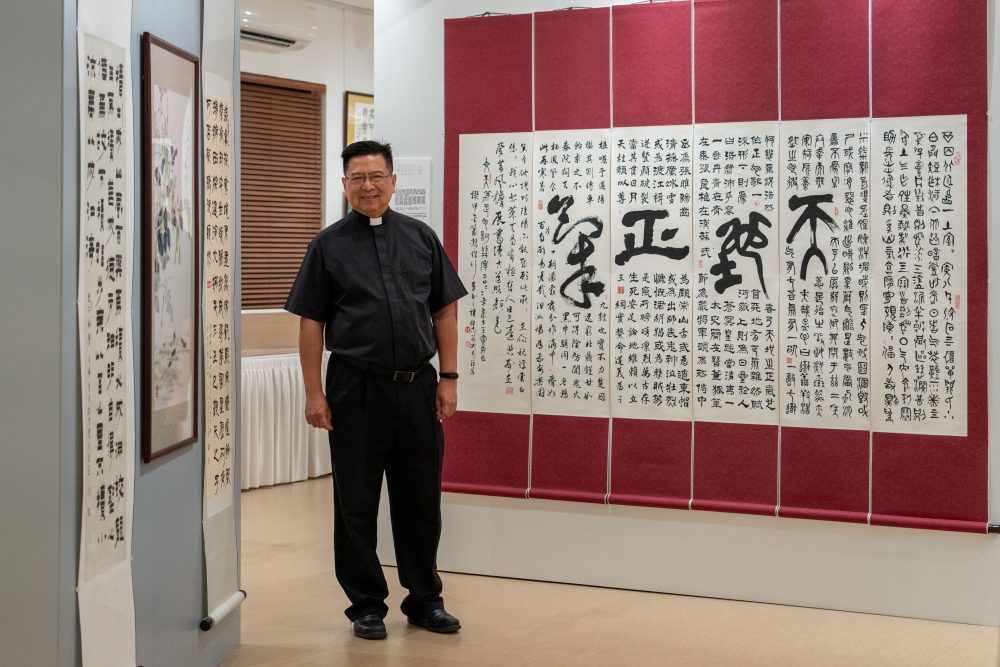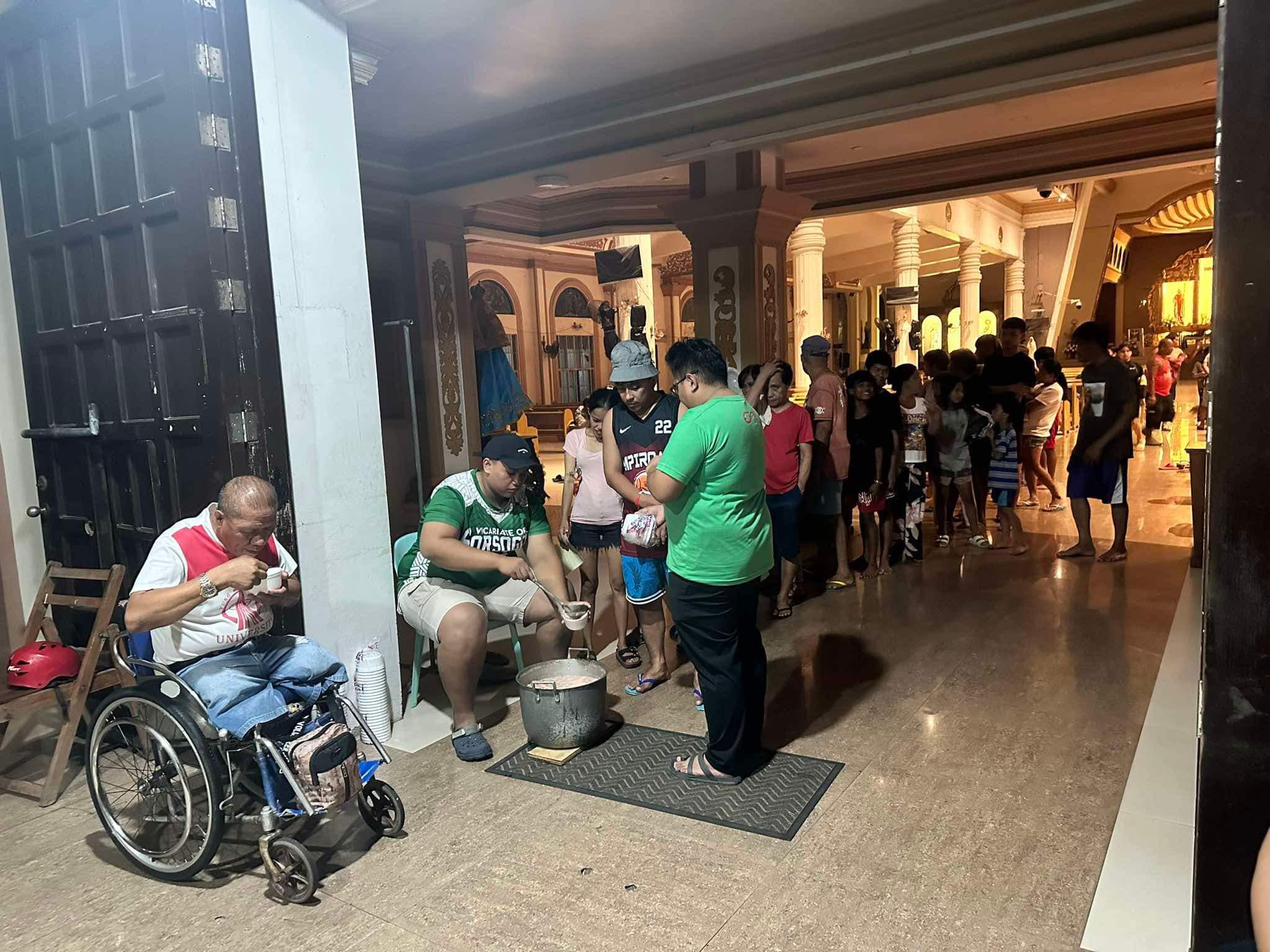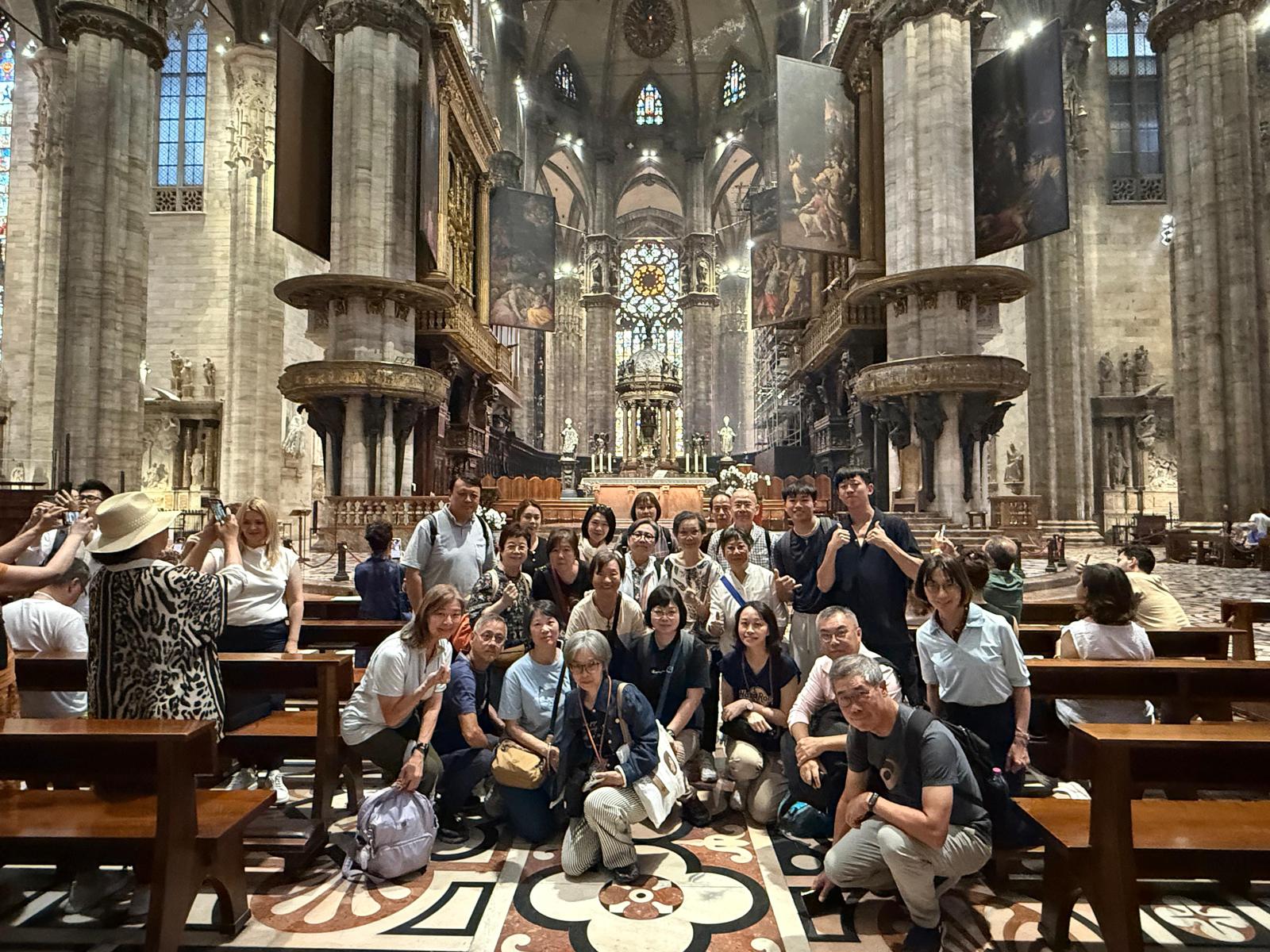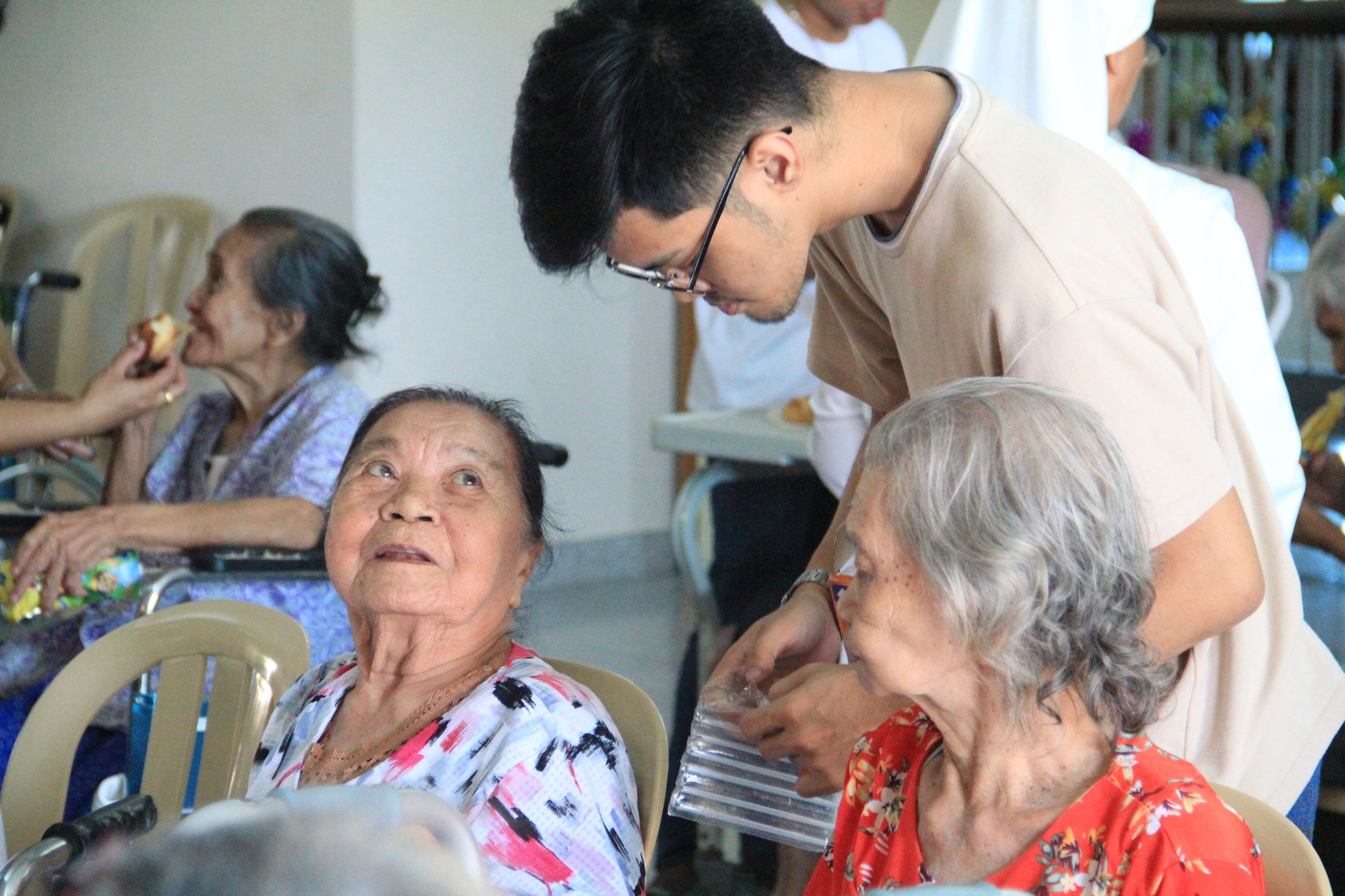Father Joseph Tham, bioethics expert
A priest, an artist and a bioethics expert with a degree in medicine. Born in Hong Kong, Father Joseph Tham balances faith, science and art in a personal journey that challenged him, in more than one perspective, to study and understand the fundamental questions that frame human existence. A teacher at the Pontifical Athenaeum Regina Apostolorum, the theologian claims that the Church’s response to the growing secularization of rules and regulation revolves around the spiritual renewal of Catholic life. O Clarim spoke with Father Tham.
Marco Carvalho
The “Art for God” exhibition, which brings together many of your most refined works of art, was recently showcased in Macau. When did you discover this passion, this talent for art and traditional Chinese painting?
Father Joseph Tham: Well, I started painting when I was 12 years old and at that time, I guess, it was mostly, because I liked it, because it was related to Chinese culture and because of the pleasure of expressing beauty in that way. When I was 15, my family moved to Canada, but, even though it was a different country and a different nation, I continued painting. That is, basically, the background. When we are young it is not easy to know why we like something, right? We have a talent and then we find something that we like and it becomes a hobby: something that we can work on and be good at. I guess this penchant for art came later. I became a priest in 2004. For a period of 10 years or so, while in the seminary, I had to put on hold my artistic activities. I had a lot of work during this time, I didn’t have a lot of free time and many of the people that were around didn’t actually knew a lot about Chinese art. Anyway, that pause was actually good. When I went back to art, I realized that it became much more an expression of my interiority. It wasn’t something that I intentionally created. My medium is Chinese painting, Chinese calligraphy and also Chinese seal carving, but, when I want to exercise it, the content comes from within, it comes from my feelings. What I want to express is, I guess, a Christian message, because that is what I am doing most of my time: I try to convey my prayers, my relationship with God, my need to thank God and love him back. It’s that sort of message. It releases itself in that way, without me really wondering about why it happens like that. It just happens, quite naturally.
Do you draw direct inspiration from the Gospel to create your works?
F.J.T: I would say that the one that in which that sort of Christian inspiration is more perceptible is my depiction of a wheat field. The wheat is always a representation of the Eucharist. The eagle flying over it is a very Chinese element. What I am saying with this particular painting is that the Eucharist, our heavenly food, gives us strength: it gives strength to the eagle, so that she could fly very high and very far. When we are talking about the spiritual realm, the Eucharist is the spiritual food that sustains us and allows us to soar into the sky. Soaring into the sky means spiritual growth and that would be a way, I suppose, to express my vision of spirituality in a subtle way. When you look at the painting, you might not see that, but it is Christian by any means.
You mentioned you became a priest in 2004. You were already a physician back then. How do you balance these three apparently contrasting aspects? We are talking about three very different realms: art, medicine and priesthood. How do you balance these three very different aspects of your experience?
F.J.T: Yes, right. I had to give up my career as a physician when I joined the seminary. It is actually a rule. Canon law is quite clear about that: a priest can not exercise the medical profession, unless he gets a special dispensation. When I joined the seminary, I was obviously answering God’s call. I didn’t really have to think too much. Becoming a priest was what God called me to do and I didn’t try to negotiate: can I do this; can I do that? What am I suppose to do in the future? I told myself: “I will leave it all to God and let it be.” My medical experience, nevertheless, was not put to waste. After I was ordained, I was asked to study Bioethics, which is related to Medical Ethics, because of my medical background. I guess the reason I was asked to do that is because my knowledge of the medical profession allows me to give the sort of insight that those that are outside the medical career might not have. Art, on the other hand, is something new. It is something that I thought was a hobby, mostly to relax and to do in my downtime but, actually, it became larger than that. The whole thing about exhibiting my work and writing a book about it isn’t really my idea. There were some people pushing me, saying: “Oh, you should do that! You should do that! You should share your art. It’s good! It´s beautiful.” In the end, I gave in. For the longest time, I said: “No, no, no. It’s too much work, it is not good enough…”.
This exhibition, nevertheless, has already toured several countries and it has always been very well received. Where you surprised by the success that it has obtained?
F.J.T: In a way, I am not sure what success means. I think, nevertheless, people are very impressed by the underlying message that I try to convey through Chinese traditional painting or calligraphy. It is something that hasn’t been done very often. Many people are surprised that this can be done at all: “Oh, I didn’t know this could be done. I have never seen this before.” It is very encouraging to me that I am on the right track, that I am not doing something strange. People usually feel that this is something original and, somehow, needed in the Church. I would call this a sort of enculturation. Matteo Ricci started that when he came to Macau and China and he tried to find convergences and similarities between the local customs, local beliefs, Confucianism and Christianity and take what is good and leave what is bad. That is enculturation.
You are doing that backwards, nevertheless…
F.J.T: Yes, I am, because I am Chinese.
That is the innovative aspect of the work that you do. There’s always been a very staunch connection between art and Christianity in the Western artistic tradition. We don’t see that as much in China. Is it challenging to achieve these results? To express the Chinese idea of harmony without failing to express the magnanimity of God?
F.J.T: For what I have seen, religious art by Chinese artists usually depicts figurative paintings or scenes from the Bible in a Chinese style. That is what we usually see, right? In terms of calligraphy, what I have seen is that calligraphers would copy a passage from the Bible and then, they make a beautiful art work and that’s it. It is the most obvious and easiest way of combining the two. I try to go, somehow, deeper. It is deeper in the sense that, being Chinese – and also maybe because of my training as a priest, as a philosopher and as a theologian – these questions come to me in a different way, a deeper way. I try to reconcile within myself these two things that are, apparently, incompatible. In a certain sense, it is a personal search for meaning, as well. Those who get it, will get it. Some people won’t get it all. That’s the way art works. It doesn’t matter. There are different levels within my creations: there is the level of aesthetics. They look at it, they admire it, they like it. And, then, there is the level of the Chinese way of looking at it, which is also seeing and understanding the technique, the maturity and the content. Maybe even the Chinese cannot understand a lot of the words, because, as you know, the words evolved through history. Some of the styles and the fonts I make use of are very ancient. Some of them are very cursive and a few won’t understand that. People will not necessarily understand everything, but that is another reason the exhibition is interesting.
As you were mentioning, you were once a physician and there’s an increasing number of dilemmas that doctors worldwide have to face, almost in a daily basis. Sixty years ago, the Second Vatican Council discussed things like contraception, for instance, but now there are many other challenging aspects. The latest, I would say, would be Artificial Intelligence. What would you say are the main challenges for the Church in this sense? What would you say are the main dilemmas physicians face worldwide?
F.J.T: Actually, this theme is very dear to me, because the focus of my Doctoral Thesis is specifically on that: on the secularization of bioethics. There’s a major change, from the influence that theology used to have to practically no influence nowadays. The largest challenge? I would put it this way: it’s the conception of what is right or wrong, the conception of who man is or what constitutes a Human person. Everything can be reduced, more or less, to this. There’s a third aspect, concerning the place of technology and how do we relate to technology. The first one, which is that of whether there is right or wrong and how these concepts became influenced or challenged by a world that has become more relativistic in the sense that, nowadays, people believe they can decide what is right or wrong. There’s not an universal concept of what is right or wrong and for the subscribers of this position, what matters the most is their own opinion. Opinions and likes have become what is right and wrong and that is dangerous in itself. That is where the world is going. That´s the danger: might is right. Whoever has more money and more power will become the one who decides what is right and wrong. We have seen that already in the past: we have seen with slavery, with the Nazi. That’s what I mean when I mention “might is right”, but that’s what we will have if we take away objective truth and morality. The second one is, actually, about our view of who we are and here is where the contrast is bigger. Catholic thinking starts from metaphysics, from a strong, Aristotelian, optimistic position of philosophy, where it is defined what is a Human person, the essence of a person. From there, we go a more practical stance. You are a person, everyone that lives is a person, but then, in extreme cases, when someone is in coma, is it still a person? Or the foetus. Is a foetus a person? The embryo is a person. That is our approach. The value we attach to a person is equal in dignity and it should have equal rights, because we are all equal, metaphysically speaking. The secular view starts more and more from the other end: the experience, the existential way. The definition of a person is based on his or her experience or on his life story. If someone has no experience – like an embryo – or if he lost the capacity to experience – like those in a coma, than basically, there is nothing wrong to forfeit their dignity, because they are no longer a person. That position is related to the other issues, like secondary sexuality, like transgenderism and same sex attraction. These things are related in someway, because the identity is no longer based in something objective, but something that is experiential. Maybe there should be a way to bridge the two phenomena, because we are talking about one and the same thing: what makes us unique as a Human person. The third one is related to technology. In a way, the advancement of technology is what causes the problem. If we didn’t have technology, some of these things wouldn’t be more than wishes. For instance, if there was no technology to threat infertility by in-vitro fertilization, the only way people could have a child was through adoption. Therefore, we have to ask ourselves: “Can we do it? Or can’t we do it?” And that, basically, touches the first two questions: “What is a Human person? What is right and what is wrong? It becomes much more difficult to contain. Technology is always advancing, always changing and there are more and more things we can do that we couldn’t do in the past. That is the challenge, hence the need to constant reflection. The new technology you talked about, artificial intelligence, it is something that we have to look at. But, basically, it is the fact that technology is always evolving that makes it difficult to make a judgment: we don’t know exactly what artificial intelligence is and where it is heading.
In the last few decades, we have seen several countries following that secularization path that you were talking about. Some of them have approved laws that authorized aspects such as euthanasia or abortion. Nevertheless, one thing is the legal framework and another, sometimes very different, is the moral and ethical framework. Is it possible to conceive the exercise of medicine merely on a legal basis, without an ethical framework?
F.J.T: Yes, that’s another issue. The Catholic position is that a law that is unjust is no law at all. An unjust law has no power. This is the Catholic position. A contrasting position is legal positivism. Basically, it claims that we don’t know what is right and wrong. There is only what is legal and illegal: whatever the judiciary or the country executive decides that is right and wrong becomes consecrated as the law. This takes away morality and ethics. These are two extremes, right? The way the doctor’s act, will depend where they stand at that. Most of the time, they are not faced with any dilemma. Most of the time, when they exercise their practice, if they follow the law of the country, they won’t face any problem. But, then, if there is a law that their conscience finds objectionable, that is when it becomes problematic. It is when we have someone that believes he shouldn’t follow that law, that it becomes objectionable. This, nevertheless, is also under attack. The possibility of going against the law by claiming objection. Many doctors are, basically, caught in this dilemma: how can they exercise objection of conscience, when they feel that the law allows it, but their conscience does not allow it. That is where doctors are at nowadays.
Some of these issues have been around for a very long time and they are still a challenge for the Church. What can the Church do in order to answer these circumstances?
F.J.T: Actually, I have thought a lot about this question. My answer may be surprising. I think that what the Church can do is, somehow, simple. First of all, it can prepare the Catholics. Non-Catholics are not the issue There is enough work to be done, so that Catholics can really understand and assimilate the Church teachings on these things. If we get all the Catholics to know the Church’s teaching, that would be undoubtedly a great advancement. For instance, abortion is not merely an issue about life. It is also about the mother. Who is going to take care of the mother? I mean, there are a lot of Catholics saying: “I will adopt the baby and take care of the mother until she gives birth”, then the problem would become less acute. That’s the first thing. But, in order to promote a larger awareness on the teaching of the Church among Catholics, spirituality, I believe, is key. If you try to convince someone by reason – look, this is the way the Church teaches and you have to follow it – it is not going to work. Somehow, Pope Francis is trying to do that. He is trying to say: “Very well, they are on the fringes, we have to bring them in”. Basically, it has to be attractive to them. Basically, what is needed is the spiritual attractiveness of Jesus. Jesus, when he meets a sinner, he loves him or her. That is unconditionally attractive: not judging or condemning them. And that, basically, is what we need to do for those inside the Church, first, and then, those outside the Church. We need to demonstrate that level of love. To answer your question, we all need to be Holy. We all need to be saints, in a certain way. Imagine Mother Theresa. When people asked her about abortion, she said: “Even if you don’t want the baby, I will take it. Anyone. You don’t want the baby, I will take it.” She had the kind of spirituality, the kind of force that allowed her to say that. If all the Catholics could do that, can you imagine what the world would be like? I think, it goes back to the question of spirituality. Spirituality is what we need to help Catholics grow more. Knowledge is important, but I think that spirituality is a key factor. If you have grown in your faith, then you will want to do the right thing and you will look to the Church for answers. It doesn’t work the other way around. You don’t look to the Church for an answer, because someone told you that this is the Church’s answer. Usually, it doesn’t work that way. You need to find something to motivate them to look for the answer and, basically, the only motivation I could see is faith. But faith has to become attractive. I think that is what the Synod is doing right now. They are trying to say: “How do you recuperate that original force of Christianity, which is basically this unconditional love. That is what is attractive, that is what changes the world. “
You were saying that spirituality might be the key to all these issues. We have been talking about the value of life and the way we relate with this concept, but there seems to also a change in the way that people understand the idea of suffering and the idea of death. Did we become indifferent to death and suffering?
F.J.T: The issue of suffering is related to one of the aspects we have been discussing: technology. Every bit of technology was created and developed to make us suffer less. Every bit of enhancement makes us suffer less. An air conditioner does that. This phone, that became a microphone, means that you don’t have to bring along a larger gadget. Everything in technology makes us more comfortable. The advancement of technology somehow has replaced religion to offer us comfort. That is the reason why I said technology and our relation to technology is an issue that we haven’t really totally come to terms with. We know that, most of the time, technology is good, but we are also afraid of it, that it could destroy us. All the projections, all the science fiction predictions, is that some technology is going to destroy us one day: some germs, some monkeys or some robots will lead to our demise. We don’t know. But that is a product of our uncontrolled use of technology. Even the Covid-19 virus was created, somehow, through this misuse of technology. I think, that somehow, technology has pushed suffering to the margin and death out of the public eye. It is not that we don’t suffer, but we don’t suffer in the same way. If we suffer a lot, basically, technology can help us. That is, for instance, the question of euthanasia: you can eliminate the sufferer or you can palliate the pain, offer him a lot of drugs, so that they don’t suffer anymore. Every major issue has to do with the relationship between human suffering and technological advancements that will allow us to overcome the suffering, starting from contraception. Contraception is the first technology that the Church was faced with, concerning birth control. Once again suffering is the key motivation. If you have too many children, they will suffer because they are poor. Can this technology be good to control population growth? That way, families would only have the number of kids that they could have. That was the first debate that the Church had to face: “Can we use this technology or not, morally speaking?” Nowadays, we are kind of facing the same dilemma. Can we use Artificial Intelligence? Can we use genetic engineering to alleviate people? The issue is always about suffering and the kind of suffering we want to overcome. There is no easy answer.


 Follow
Follow


